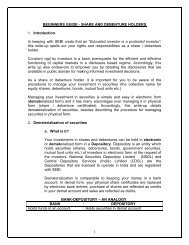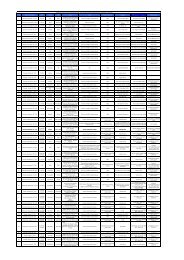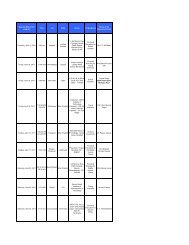financial planning 3. - Securities and Exchange Board of India
financial planning 3. - Securities and Exchange Board of India
financial planning 3. - Securities and Exchange Board of India
- No tags were found...
You also want an ePaper? Increase the reach of your titles
YUMPU automatically turns print PDFs into web optimized ePapers that Google loves.
Activity(The activity below is designed to help you in setting a <strong>financial</strong> mission <strong>and</strong> a vision.)Activity: read the questions carefully <strong>and</strong> answer them honestly.Your present: What is your current <strong>financial</strong> position? Where do you st<strong>and</strong> today?Your future: What is your <strong>financial</strong> plan for the future? Say 10 years from now!Your reality: Do you have the skills to help you get there? How do you plan to get there?Planning for the future involves setting goals <strong>and</strong> objectives.For each goal, be sure to consider two very important aspects, your risk tolerance <strong>and</strong> the timeframe within which you wish to achieve these objectives. Your personal level <strong>of</strong> risk tolerancewill give you an idea in which securities you need to invest in <strong>and</strong> for how long in order toachieve the set objectives. The duration <strong>of</strong> a <strong>financial</strong> plan depends on the goals that it sets outto achieve. It can cover short-term, medium-term <strong>and</strong> long-term goals. Short-term goals arenormally targeted in a one to three year framework; for example a vacation abroad, mediumtermgoals fit into a three to five year horizon; for example, buying a home; <strong>and</strong> long-termgoals are achieved in a period <strong>of</strong> five years or more; for example, retirement <strong>planning</strong>.It is also important to consider your income per year <strong>and</strong> your level <strong>of</strong> savings. For example,you earn Rs 180,000 a year <strong>and</strong> save 20% <strong>of</strong> it (Rs 36,000). You plan to send your child toMumbai to complete his/her education <strong>and</strong> approximate a budget <strong>of</strong> Rs 200,000. Your child isto complete his HSSE education in four years. Thus, based on your risk tolerance you allocatemoney towards his education. If your risk tolerance is low, it may be difficult to fulfill your goal<strong>of</strong> sending your son to Mumbai to complete his education. But if you are someone who is notafraid to take risks, it is possible to make your dreams come true. Investing money in fundshigher on the risk return scale is one possible solution.Suppose you invest Rs36,000 in the first year, Rs25,000 in the second year, Rs30,000 each in thethird <strong>and</strong> fourth year respectively, your total investment at the end <strong>of</strong> the four year is Rs121,000.Investing in securities that yield an average <strong>of</strong> 22% rate <strong>of</strong> return can enable you to fulfill yourgoal <strong>of</strong> sending your child to Mumbai for his education.8
















